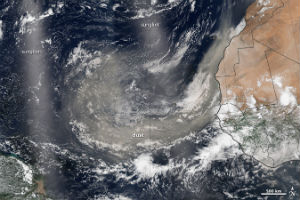Mysterious giant dust particles found at gravity-defying distances
12 December 2018

An unknown influence is allowing giant dust particles to spread around the world and could be contributing to global warming, scientists have found.
Large dust particles from the Sahara Desert have been found up to 3500 km away in the Caribbean. These were nearly 50 times bigger than scientists thought was possible to be transported such a distance via global winds.
Dust affects the delicate balance between incoming sunlight and heat emitted from Earth, tropical cyclone development and the formation of clouds. The scientists say the large particles’ role in the atmosphere, with their unexpected long-range effects, should be included in climate models in future.
"Existing ideas do not allow for such massive particles travelling in the atmosphere for such vast distances" - Professor Giles Harrison, University of Reading
Professor Giles Harrison, Professor of Atmospheric Physics at the University of Reading, and a co-author of the study, said: “These dust particles are whipped up from the Sahara Desert and carried between continents, and most people know them best when they end up settling on our cars or cause the kind of eerie orange skies we saw a year ago.
“However, existing ideas do not allow for such massive particles travelling in the atmosphere for such vast distances, suggesting that there is some as-yet-unknown atmospheric process or combination of processes keeping them airborne. Charging of the particles and associated electric forces is one avenue being explored.
“This evidence of dust and ash being carried so far is significant because these particles influence radiation transfer around the Earth and carbon cycles in the oceans.”
Role of large dust particles 'underestimated'
The research, led by the Royal Netherlands Institute for Sea Research (NIOZ), is published today in Science Advances.
Winds carry dust particles from the Sahara west over the Atlantic Ocean. The researchers collected desert dust in floating buoys and underwater sediment traps in five locations in the Atlantic Ocean between 2013 and 2016.
It was previously thought the size of the particles in this cloud ranged from 0.01-0.02mm in diameter, but scientists found particles measuring 0.45mm in samples in the Caribbean.
The scientists argue this means the role of large dust particles, especially quartz, in both cloud formation and the carbon cycle in the oceans has been underestimated. The role of the particles is largely neglected in computer models used to explain and predict climate change because they have not been thought to persist in the atmosphere.
The research also suggests the amount of dust removed from the atmosphere by rain, rather than gravity, is greater than previously assumed. This has implications for the oceans, because droplets formed by dust particles are highly acidic and because the large particles sink faster, carrying the nutrients to deeper parts of the ocean. Both these factors impact algae growth and therefore affect food chains and the ocean carbon cycle.
Michele van der Does, a PhD researcher at NIOZ and lead author of the study, said: “The fact that larger particles of dust keep floating in the atmosphere for a long time is considered to be in conflict with the physical laws of gravity. We show that through a combination of forces and movements in the atmosphere the large dust pellets can indeed stay in the atmosphere for a longer time and have their influence there.”
Full reference:
Van der Does, M., Knippertz, P., Zschenderlein, P., Harrison, R.G., Stuut, J-B.W (2018). ‘The mysterious long-range transport of giant mineral dust particles’. Science Advances. DOI: 10.1126/sciadv.aau2768
Image credit: NASA
